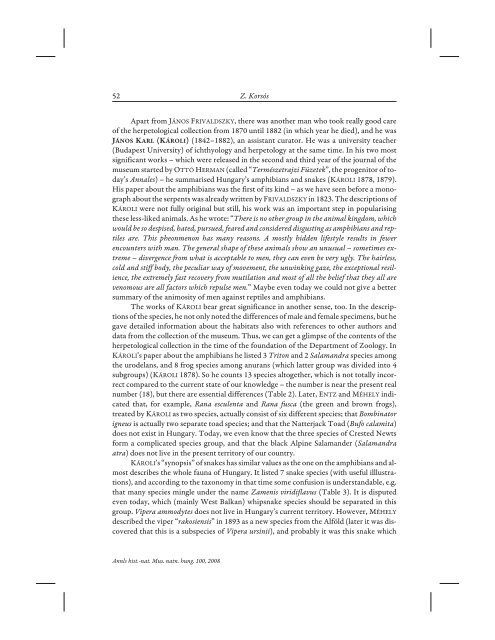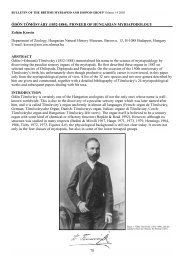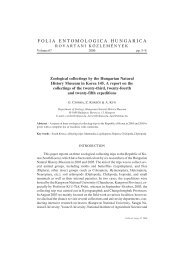History of the Herpetological Collection of the ... - Korsós Zoltán
History of the Herpetological Collection of the ... - Korsós Zoltán
History of the Herpetological Collection of the ... - Korsós Zoltán
Create successful ePaper yourself
Turn your PDF publications into a flip-book with our unique Google optimized e-Paper software.
52 Z. Korsós<br />
Apart from JÁNOS FRIVALDSZKY, <strong>the</strong>re was ano<strong>the</strong>r man who took really good care<br />
<strong>of</strong> <strong>the</strong> herpetological collection from 1870 until 1882 (in which year he died), and he was<br />
(1842–1882), an assistant curator. He was a university teacher<br />
(Budapest University) <strong>of</strong> ichthyology and herpetology at <strong>the</strong> same time. In his two most<br />
significant works – which were released in <strong>the</strong> second and third year <strong>of</strong> <strong>the</strong> journal <strong>of</strong> <strong>the</strong><br />
museum started by OTTÓ HERMAN (called “Természetrajzi Füzetek”, <strong>the</strong> progenitor <strong>of</strong> today’s<br />
Annales) – he summarised Hungary’s amphibians and snakes (KÁROLI 1878, 1879).<br />
His paper about <strong>the</strong> amphibians was <strong>the</strong> first <strong>of</strong> its kind – as we have seen before a monograph<br />
about <strong>the</strong> serpents was already written by FRIVALDSZKY in 1823. The descriptions <strong>of</strong><br />
KÁROLI were not fully original but still, his work was an important step in popularising<br />
<strong>the</strong>se less-liked animals. As he wrote: “There is no o<strong>the</strong>r group in <strong>the</strong> animal kingdom, which<br />
would be so despised, hated, pursued, feared and considered disgusting as amphibians and reptiles<br />
are. This pheonmenon has many reasons. A mostly hidden lifestyle results in fewer<br />
encounters with man. The general shape <strong>of</strong> <strong>the</strong>se animals show an unusual – sometimes extreme<br />
– divergence from what is acceptable to men, <strong>the</strong>y can even be very ugly. The hairless,<br />
cold and stiff body, <strong>the</strong> peculiar way <strong>of</strong> movement, <strong>the</strong> unwinking gaze, <strong>the</strong> exceptional resilience,<br />
<strong>the</strong> extremely fast recovery from mutilation and most <strong>of</strong> all <strong>the</strong> belief that <strong>the</strong>y all are<br />
venomous are all factors which repulse men.” Maybe even today we could not give a better<br />
summary <strong>of</strong> <strong>the</strong> animosity <strong>of</strong> men against reptiles and amphibians.<br />
The works <strong>of</strong> KÁROLI bear great significance in ano<strong>the</strong>r sense, too. In <strong>the</strong> descriptions<br />
<strong>of</strong> <strong>the</strong> species, he not only noted <strong>the</strong> differences <strong>of</strong> male and female specimens, but he<br />
gave detailed information about <strong>the</strong> habitats also with references to o<strong>the</strong>r authors and<br />
data from <strong>the</strong> collection <strong>of</strong> <strong>the</strong> museum. Thus, we can get a glimpse <strong>of</strong> <strong>the</strong> contents <strong>of</strong> <strong>the</strong><br />
herpetological collection in <strong>the</strong> time <strong>of</strong> <strong>the</strong> foundation <strong>of</strong> <strong>the</strong> Department <strong>of</strong> Zoology. In<br />
KÁROLI’s paper about <strong>the</strong> amphibians he listed 3 Triton and 2 Salamandra species among<br />
<strong>the</strong> urodelans, and 8 frog species among anurans (which latter group was divided into 4<br />
subgroups) (KÁROLI 1878). So he counts 13 species altoge<strong>the</strong>r, which is not totally incorrect<br />
compared to <strong>the</strong> current state <strong>of</strong> our knowledge – <strong>the</strong> number is near <strong>the</strong> present real<br />
number (18), but <strong>the</strong>re are essential differences (Table 2). Later, ENTZ and MÉHELY indicated<br />
that, for example, Rana esculenta and Rana fusca (<strong>the</strong> green and brown frogs),<br />
treated by KÁROLI as two species, actually consist <strong>of</strong> six different species; that Bombinator<br />
igneus is actually two separate toad species; and that <strong>the</strong> Natterjack Toad (Bufo calamita)<br />
does not exist in Hungary. Today, we even know that <strong>the</strong> three species <strong>of</strong> Crested Newts<br />
form a complicated species group, and that <strong>the</strong> black Alpine Salamander (Salamandra<br />
atra) does not live in <strong>the</strong> present territory <strong>of</strong> our country.<br />
KÁROLI’s “synopsis” <strong>of</strong> snakes has similar values as <strong>the</strong> one on <strong>the</strong> amphibians and almost<br />
describes <strong>the</strong> whole fauna <strong>of</strong> Hungary. It listed 7 snake species (with useful illlustrations),<br />
and according to <strong>the</strong> taxonomy in that time some confusion is understandable, e.g.<br />
that many species mingle under <strong>the</strong> name Zamenis viridiflavus (Table 3). It is disputed<br />
even today, which (mainly West Balkan) whipsnake species should be separated in this<br />
group. Vipera ammodytes does not live in Hungary’s current territory. However, MÉHELY<br />
described <strong>the</strong> viper “rakosiensis” in 1893 as a new species from <strong>the</strong> Alföld (later it was discovered<br />
that this is a subspecies <strong>of</strong> Vipera ursinii), and probably it was this snake which<br />
Annls hist.-nat. Mus. natn. hung. 100, 2008




